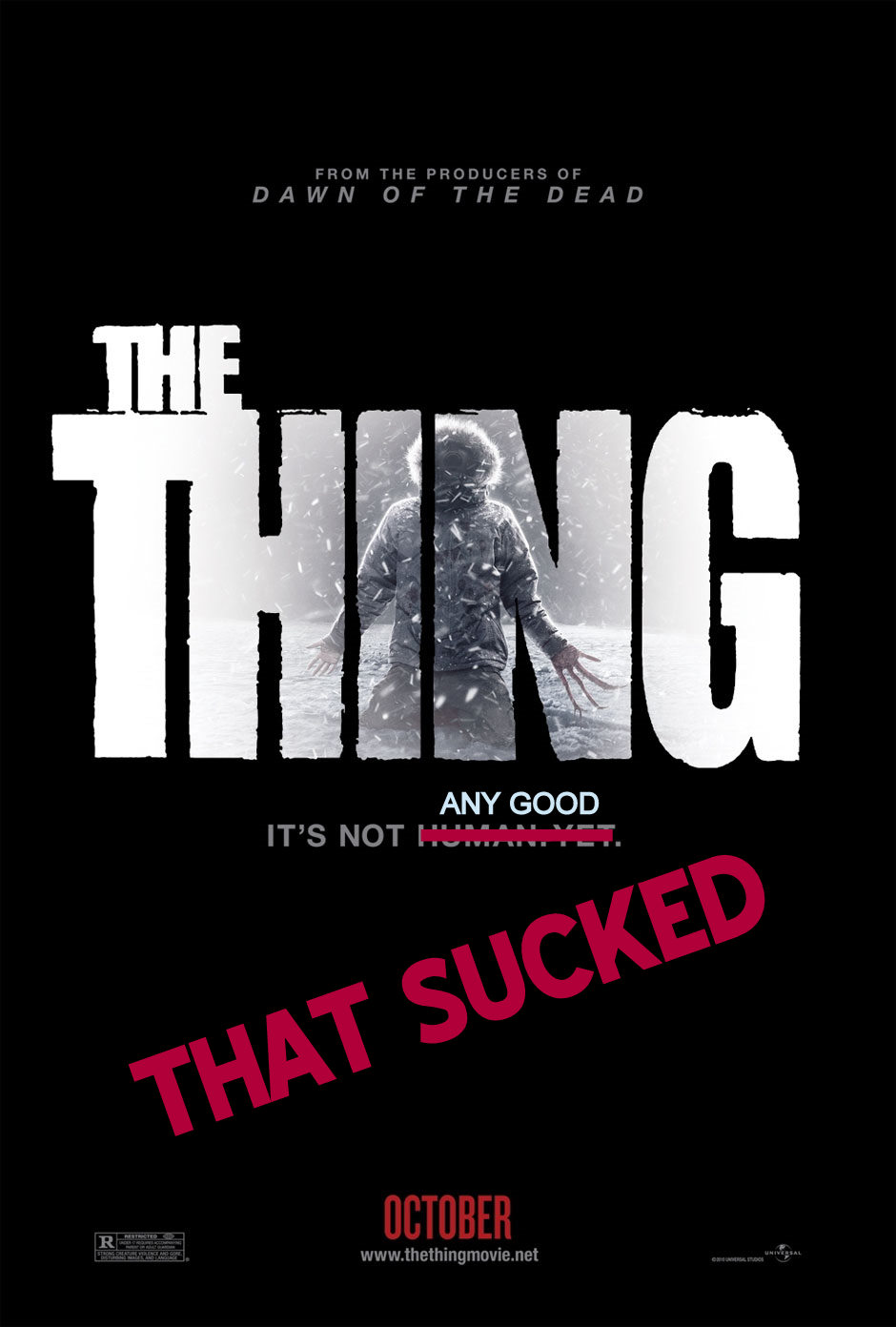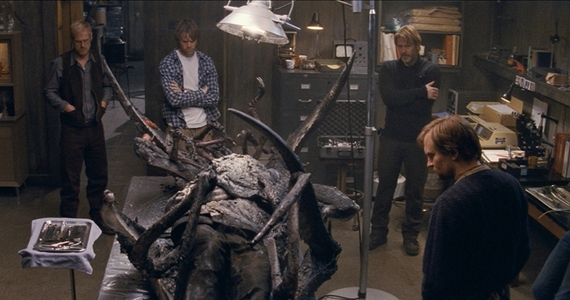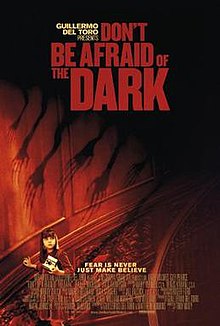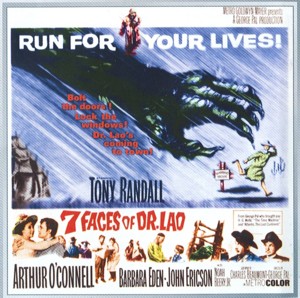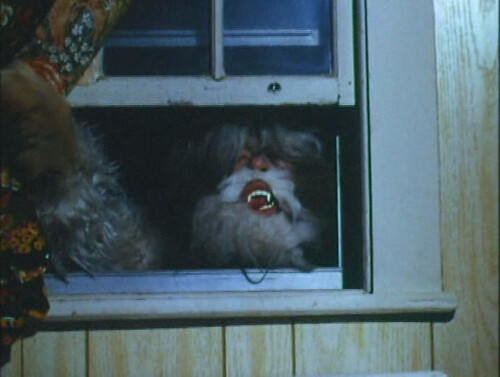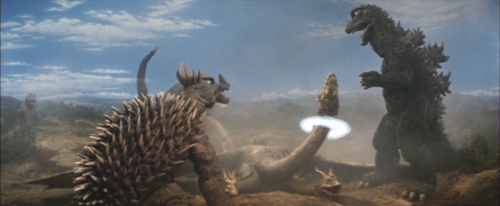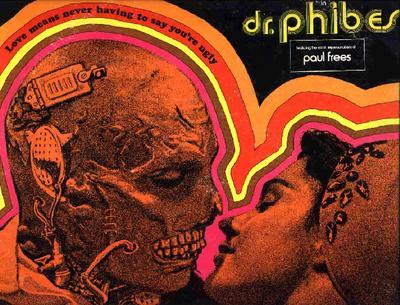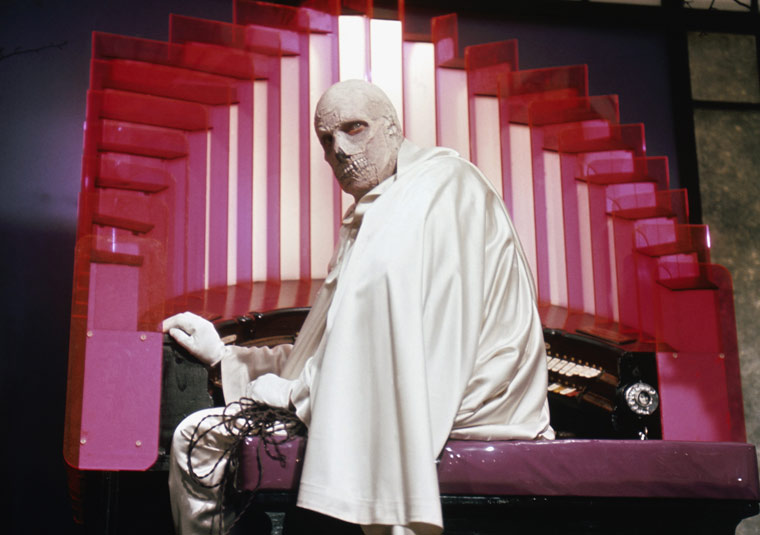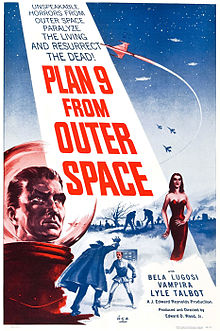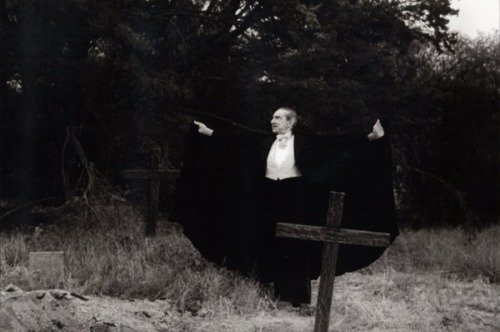by Bill Breedlove
How exciting! Another “top ten” list on the Internet! But, before we get to all that excitement, by way of background, let’s take a really, really long detour to see how we arrived here: Last year, 2011, I was irrationally excited for two motion pictures.
One was the prequel/remake/reboot of John Carpenter’s 1982 masterpiece, THE THING (cleverly also titled "THE THING"). Each year that goes by raises the stature of the Carpenter version, which suffered a totally unjustified pasting back during its original release. From the moment the 2011 THING was announced, it seemed all everyone on the Internet could do was bash it for one thing or another (see what I did there?). Sure, I was filled with trepidation as well (Who, exactly, was the genius who watched the 1982 film and said, "Boy, is it just me or does everybody wonder what the heck happened before this picture started?"), and given how the Carpenter film does start, it sorta ruins the whole "suspense of the ending" kind of thing for the prequel/remake/reboot. (see, i just did it again! this is comedy gold!) But, in spite of that--and the increasingly desperate pleas of the cast, crew and studio executives that "We didn't make a crappy movie!" (perhaps the greatest red flag there is--imagine if you lived with a roommate and one day when you got home, the first thing (I promise I will stop) the roommate said to you when you walked in the door was "I swear to god I have no idea where that mysterious stain on your bed came from but it certainly was not me!" Hmmmm.) I could still not squelch the excitement as I sat down to watch the movie. And, boy did it suck ass.
I am sure that all parties involved in making the film had only the best intentions, but I cannot for the life of me think of even one thi--...erm...component of the new version that was AS GOOD AS--let alone better--than the 1982 version. The cast? Not even close. Keith David! Wilford Brimley! Kurt Effing Russell! Even Donald " I know you gentlemen have been through a lot, but when you find the time, I'd rather not spend the rest of this winter TIED TO THIS FUCKING COUCH!" Moffat is better than anyone in the new version.
It doesn't help that the majority of the people at the research station in this one are non-english speaking Nordic looking actors with beards. Except the one guy in the previews whose face is shown shifting while he is riding in the helicopter--since he is the only guy in the movie with black hair and a beard, and kinda reminds me of a low-rent Javier Bardiem, as soon as he showed up, it destroyed what little suspense already existed.
How about the iconic "blood test?" No, in this one they used the fact that THE THING cannot thing-ize non-organic materials when becoming something else. So, instead of the Petrie dish hot metal test, we have the chick from Scott Pilgrim shining a flashlight into everyones' molars' to check who doesn't have any fillings. (And, several lovingly long close ups of one character's $5 Claire's stud earring. Huh. I wonder if that will come into play later?
No, of course not. This is 2011, the brain trust at Universal Studios could not possibly think any collective audience is that stupid. Oh, never mind.)
Well, at least the special effects should be amazing! Way back in the "dark ages" of 1982, they had to actually use latex, and hoses and armatures and stuff, so with the CGI effects that are available now, there should be hella great Thing action!
But, not exactly.
Sure, there are interesting effects--there's a lady who splits into a giant fang mouth with tentacles, there's the Javier Bardiem guy/thing in the helicopter, there's the upside-down semi-merged two people (which will become the burned out semi-merged body found by the 1982 scientists) that walks like XTRO, and, finally, there's the "spaceship Thing" which has the Bad-Doctor-Who-Started-All-This-Mess's face and head (looking about as real as the same sort of effect did in FROM BEYOND) and 10,000 tentacles with sharp teeth and a huge Vagina Dentata sideways mouth that opens and stays obligingly open long enough for the Scott Pilgrim girl to toss a grenade in it ala JAWS (another Universal picture, natch).
There are two problems here: 1) While surely the very best 2011 has to offer, the SFX aren't engaging because we both don't care (really) about any of the characters (except maybe the Scott Pilgrim girl and the helicopter pilot guy), so while the rest of the characters were THINGing out, it was hard to keep track of who was what; and 2) there weren't any "Wow!" moments. In the 1982 version, when Dr. Copper is giving the electronic CPR paddles to Norris, and Norris' chest opens up into shark jaws and bites his arms off, it is a shocking moment. Then, while the audience is going "WTF?" (or, whatever served as "WTF?" back in 1982), the scene continues as they use a flamethrower to burn the increasingly tentacled Norris, but of course, his neck stretches extra long and eventually ruptures, causing his head to fall to the ground, which causes a whiplike tongue to grab a desk corner and pull the headTHING out of harm's way, whereupon spider legs pop out of the sides (making a PERFECT skittering sound on the floor) and then two large eye stalks come up--all this from an upside down severed head. The head, with the legs and stalks, hides under a desk and peeks out cautiously to see if it is safe.
THERE!!
Right fucking there!
At that moment, after the audience has been tenderized by the previous minute's carnage, they are looking at this...THING...and it seems like a living, breathing THING, not a mess of special effects. When the human are all turned looking at the burning corpse of NorrisThing, the headthing tries scuttling out of the room (again with the perfect sound design), leading to Palmer turing to follow it with disbelieving eyes and uttering PRECISELY what the audience has been thinking "You gotta be fucking kidding!" which is a laugh line releasing the tension. In the 2011 THING, there is no comparable moment. It's just all tentacles, and teeth and people splitting open to show interior tentacles and teeth.
And, since we're on that subject, that's even more annoying. The whole premise of THE THING (and its source material, the great John W. Campbell, Jr. story "Who Goes There?") is that the THING is a chameleon, that it does not EVER want to show itself, it has adapted the incredible trick of being able to mimic its prey perfectly. In the 1982 movie, the only time the THING revealed itself was when it was forced to BECAUSE IT WANTED TO HIDE. That is the entire basis of its successful evolution--to not be seen. In the 2011 version, the THING just randomly bursts out of its human disguise at the machinations of the plot. And, again, the whole point of the THING being successful is replicating its victims as quietly as possible, so others do not know what is happening, and attempting to survive at all costs. Remember that "headTHING" dragging itself by the tongue to safety and then attempting to skitter away when nobody was looking?
Contrast that with the 2011 THING where there are four passengers in a helicopter. One of them is a THING. After (AFTER!) the helicopter is high in the air, it stands up and bursts open, all teeth and tentacles. Why? By doing this, it (of course) causes the helicopter to crash, thereby killing itself. And so on and so on. The 2011 THING just explodes from human to fangs/tentacles/fanged tentacles for no apparent reason, alerting all the other humans around because it is making a whole heck of a lot of racket, with all those swishing tentacles and chomping fanged mouths. Finally, the movie is not in the slightest bit scary. If you had seen the 1982 THING (and, if you have not, why would you be interested in going to see this one? So, they had to figure most of their audience already knew the source film), you already know how this is going to end.
SPOILER ALERT: In the 1982 THING, there were only two Norwegians left alive, and they were chasing the huskyTHING which ran to the American camp, while the Norwegians shot at it from a helicopter. Quickly, both of those Norwegians were dispatched, meaning the only survivor of the "prequel" would be the huskyTHING. Thus, everyone in the film is going to die! From the first minute! It is not a question of who will die, but when.
Of course, we know Scott Pilgrim Girl and Helicopter Pilot guy will be close to the last two humans left. Now that "suspense" has been removed, are there any frightening or creepy moments in the film? Alas, no. Not a one. Again, to unfavorably compare 1982 to 2011, look at this scene from the earlier version, when everyone discovers "the problem with Bennings"
It is weird, creepy and (oddly) moving, especially the THINGscream at the 1:32 mark. You really get the sense there IS a THING and it IS from another world. All that, with a decent actor, two rubber monster hands and a ADR scream. Nothing--nothing--in the 2011 comes remotely close to that. Needless to say, I was a little bit bummed after that.
Fortunately, the other movie I was really looking forward to was the remake of a flick that had scared the bejesus out of my as a kid--DON'T BE AFRAID OF THE DARK. And, this was being "created" (but not directed, per se) by Guillmero del Toro, who a) makes great movies; b) loves monsters; and c) wanted to modernize DBAOTD because--wait for it--it scared the bejesus out of him as a kid. Yowza! What could possibly go wrong? Guy Pearce—between L.A. CONFIDENTIAL, RAVENOUS, THE PROPOSITION and his new starring cameo as “Peter Weyland”—is reliably awesome. Katie Holmes is…well, remember Guy Pearce is in this movie! Anyway, on with the DVD, and wow, does this sure look promising. The house is absolutely terrifying, the atmosphere (per del Toro, as usual) is amazing, and the dread just oozes from the frame.
The story has been slightly changed. In the original DBAOTD, the young wife (played by Kim Darby—she had an interesting 2010, with probably her two most well-know roles—this one and “Hattie” in True Grit—being remade. While she probably was wondering why her, at least it probably sparked renewed interest in the originals) is the one who discovers and ultimately becomes the target of the little homunculi—and in this version there is a little girl who becomes the focal point of the little monsters.
I watched this entire movie closely, and I have to say, it looked great, the acting was very good (even Katie Holmes!), and the special effects were exceptionally well done. That said, this was less significantly less frightening than an episode of “Hoarders.” Of course, we need to get the big caveat out in the open right away: I am not a little kid now, as I was the first time I watched DBAOTD, so that should be taken into account. However, given that pretty much EVERYTHING in this version is far superior to the original, what happened? Aside from my “adulthood” (which no doubt my wife would have some comment on), I think the bigger problem is that the monsters were definitely creepy, but ultimately not very scary.
I am going to reference something film critic Gene Siskel said back somewhere in the 1980s. I believe he was talking about the highly interesting Stuart Gordon film DOLLS (1987), but I am far too lazy to go scour the internet for this particular clip. In any event, what he was referring to is movie monsters that are little. He said that it is very difficult for filmmakers to make little monsters scary, since people can just sort of brush them off. (Of course, I do not recall him utilizing this same line of thought when ARACHAPHOBIA (1990) came out…) I also want to believe he referenced the Xenomorph from ALIEN (1979) in a more appropriately frightening sized creature. (Stay tuned, I will have an even better and more appropriate bit I nicked from Gene Siskel later in this column).
And that is part of the problem here. Sure, the little gnomes have knives and scissors and other weapons, but they still are awfully small and frail looking. At the climax, one of them even gets flattened nicely, and one has to wonder why the characters did not take this method of problem-solving into account sooner. But, that is irrelevant, really, as things were similar in the original version (with FAR inferior special effects)—and the twin propositions of fear—one, that monsters will get you when the lights go out; and two, no matter what you say, no one will believe you—worked just fine then.
So, we have one wretched remake, and one that was very well made but not really an improvement on the original, and that led me to wonder—why even have remakes at all? Everybody has an opinion on remakes like the Rob Zombie HALLOWEENs and the endless FRIDAY THE 13th and NIGHTMARE ON ELM STREET reboots/reshoots/reimagining of which I think everybody is also in agreement that exactly none of them improve upon the original source material. Even the lamentable--and excoriated—I SPIT ON YOUR GRAVE, probably the least likely candidate for a “remake” ever got the treatment in 2010.
What is it then that makes horror films seemingly irresistible for studios to redo them—ALL of them?
I mean, honestly, was anyone really clamoring for a FRIGHT NIGHT remake? Who are these people?
With all this in mind, I sat down to try and think of horror movies that I would like to see remade—you know, ones that improved technology, a bigger budget, better actors and crew would actually make BETTER. In doing this, the only real rule I had was that any potential remake candidate had to be at least 25 years old. That sounds like a long time, until you realize that means films made as late as 1987 apply. I know that all the fans of KILLER KLOWNS FROM OUTERSPACE (1988) and PUMPKINHEAD (1988) will be bitterly disappointed, but, hey, it’s my column, my rules.
He has a great point. Aside from the factor of being able to guarantee name-recognition, why do they always remake movies that were perfectly well done the first time around? Why not take a film that made a huge crucial mistake somewhere along the way, fix that mistake and then see how it would play out? I suppose that makes too much sense for Hollywood. And, I have to admit, I did not entirely follow that advice faithfully in compiling my list. Some of the films were indeed terrible as originally made, but also some were perfectly serviceable, but also could be supremely improved with a remake using 20/20 hindsight. With that in mind, let’s look—in reverse order, counting down to number one—at the Top Ten Horror Films That Should Be Remade:
10. GHOST STORY (1981)
This might be the biggest no-brainer on this list. GHOST STORY, the novel by Peter Straub, is one of the great masterpieces of gothic horror literature. And, by “gothic” I mean a very densely-constructed plot with wheels within wheels within wheels, where characters, their relatives and other selves intersect and go spinning off into stories of their own and so on and so on. And, yet, Straub maintains all those spinning plates perfectly, and by the end of the book, all those seemingly random threads begin to come together to a satisfying conclusion. Alas, the film version pretty much scotches all that. It takes the dominant plot—that of four old men (“the Chowder Society”) and the secret they harbor which eventually manifests enough to destroy them and their quaint winter-bound village of Milburn. Granted, it would be exceedingly difficult in the span of a two hour film to cover—let alone do justice to—all of Straub’s characters, ghouls and beasties—that would probably better be served in a mini-series (a CABLE miniseries) for a lot of the same reasons ‘SALEM’S LOT has always been adapted that way.
But, another great failing of the film version of GHOST STORY has to do with the time and place in which it was made. On one hand, there is an obvious love and reverence for the cast of distinguished actors who portray the Chowder Society (Fred Astaire! Doulgas Fairbanks, Jr.! Melvyn Douglas! The great John Houseman!), but that is also part of the problem. The gents seem very frail at this stage of their careers, and so most of their roles consist of speaking to each other, in a somewhat stylized way reminiscent of a play. Which is all well and good…if you’re watching a play. And, that would not even be a serious problem if the two younger “good guys” in the book were available to provide a counterpoint. Young Peter Barnes from the novel is completely abandoned in the film version, and the role of Donald Wanderly is filled by the less-than-arresting Craig Wasson. (And, honestly, what blackmail photos did Wasson have on the Hollywood community in the 1980s? Between this role and his headliner in Brian DePalma’s BODY DOUBLE he very nearly manages to wreck two movies single-handedly. The only thing I can think of is both directors hired him for his ability to look really baffled and frightened—which he excels at in both films.)
Finally, there is the production values, which, again, are a thing of the time this film was made. At times, it looks like it was shot on the old Universal backlot, complete with the stock heavy-on-the-strings orchestral score. Generously, we can give them the benefit of the doubt as far as special effects are concerned, so you know that would be improved, oh, say, like 10,000% in the second decade of the 21st century. Aside from the performances of the 4 leads (sorry, Mr. Wasson), which perhaps are more sentimental favorites than for the actual performances in this film, there is NOTHING in the film version of GHOST STORY that could no be improved with a remake. Most of all, the hugely anti-climatic ending of the film—which has absolutely nothing to do with the novel—involves Fred Astaire flagging down the police to pull a car from a lake, while, at the same time, our good friend Craig Wasson sits immobilized while a ghost/Eva Galli/Alma Mobley walks exceptionally slloooooowwwwlllllyyyy down a hall and descends a staircase before disappearing into a puff of smoke when the car is pulled form the lake and the rubber skeleton tumbles onto the ground. Really? Really? We can do better!
9. THE 7 FACES OF DR. LAO (1964)
If you have not seen this film, I encourage you to stop reading and go watch it. It may be somewhat difficult to track down a copy, but it is well worth it. This is one of those pictures that seems to have sort of fallen through the cracks in movie buffs discussions. It is based (extremely loosely) on a Charles Finley novel. The film itself was directed by the great George Pal. The plot involves a strange traveling circus which comes to a small town and shows some of the residents particular insights. In a way, the circus is the opposite of the dark carnival in Bradbury’s SOMETHING WICKED THIS WAY COMES. Instead of wanting to destroy the townspeople, ala the evil Mr. Dark, this traveling show wants to help them, as evidenced by the many faces of the proprietor, the kindly Mr. Lao. And, what a piece of work this Mr. Lao is—over the course of the film he assumes many shapes, including Medusa, Merlin and Pan. He is revealed to be a 7,000+ year-old wise man who seems Asian but wears a sombrero. For this expansive role, the producers selected none other than Tony Randall(!). While known to most people these days as the fussy Felix Unger from the television series version of Neil Simon’s THE ODD COUPLE, Mr. Randall may not seem to be the first choice to portray, say, the suave and insinuating satyr Pan. But, to his credit, he is very good in this film, although frequently buried under enormous amounts of latex and makeup.
Even better, there are a few stop-motion sequences created by a very young Jim Danforth, including a very Willis O’Brien-esque “Loch Ness Monster” which clearly references the master’s Brontosaurus from the original LOST WORLD. So why remake this obscure and perfectly pleasant (as is) little film? First, with the advances in special effects and make-up, the various creatures and scenarios created by Mr. Lao would certainly be eye-candy. But, also, the film’s not-so-subtle but upbeat message would be a welcome addition to a movieplex that is often highly cynical. This material is perfect for a big-budget showy, 3-D remake! Plus, did I mention Medusa? The Loch Ness Monster? Even the Abominable Snowman makes a cameo!
8. SHRIEK OF THE MUTILATED (1974)
Speaking of our old friend, the Abominable Snowman (or his cousin, the Yeti), we come to the first truly, truly awful film on the list. This movie has gotten some ongoing attention, largely from proponents of “bad movie” websites, and from people who lump it into the “so bad it’s good” (also known as the “watch this while you’re stoned, it’s HILARIOUS) category. It’s probably debatable whether the intentions of the filmmakers were to make a “serious” horror film, or whether this is all intended as a sort of goof (as evidenced by the last line of the film). What is not really debatable is how poorly made this film actually is. The directing, the acting, the cinematography – all of which could be listed with ironic quotes – are just bad, bad, bad. (Even by the DIY standards of the early 1970s). The “special effects” (couldn’t resist)—forget about it. So, why on earth would anyone in his or her right mind even consider remaking this stinker? Well, somewhat surprisingly, there is…something…about this film that is unnerving.
Plot spoilers aside, a movie about a bunch of students who travel with their slightly daffy professor to an island in search of the Yeti—even after being told in vivid detail about what happened to the Professor’s ill-fated last student expedition—is a pretty good hook. And, with a great title like “Shriek of the Mutilated” we know some serious Yeti action is bound to go down. To its credit, the film even had one of those now-commonplace seeming “shocking” climaxes that would probably still work today, for the few kids who didn’t go to Wikipedia and spoil the ending. With “professional” actors, a similarly-inclined crew, a talented director—c’mon David Fincher, you know you could do wonders with this material!—a sprucing up of the script, and perhaps some new sound FX to replace the present questionable utterances of the Yeti, and we would definitely have a winner. (Or, another idea for an interesting film could be a version of the real life couple behind this film: Michael and Roberta Findlay. Really.)
7. THE CREEPING FLESH (1973)
This one really leaves me torn, because on one hand, is it not sacrilege to consider remaking a film that (once again) pitted Christopher Lee against Peter Cushing in a atmospheric English chiller directed by Freddie Franics – with the inevitable Michael Ripper cameo? On the other hand, this is not just a “monster” movie, but also delves into some really interesting issues about the nature, as it were, of “evil.” While this is not, technically, a “Hammer” film, it seems like it has all the traits: Aside from the two most famous actors associated with the studio, the most frequent director of the “classic” Hammer films, and the ubiquitous—and gloriously monikered—Mr. Ripper, it has two insanely competitive brothers; one who has apparently constructed Dr. Frankenstein’s laboratory and the other who just happens to run an insane asylum; a mother with insanity and a daughter who is terrified of the heredity aspects of insanity; oh, and a giant fucking skeleton that may or may not be alive. Whew! What’s even more interesting in this picture is that, in one of those rare cases, Chris Lee is not the “evil” one. The case can be made that either neither, or both, of the brothers is equally benign or equally evil. Lee locks his sister-in-law, his daughter-in-law and (eventually) his own brother away in his questionably-run laughing academy. And, perhaps most important to the arc of this particular story, he also attempts to steal his brother’s prized discovery—that giant fucking skeleton.
But, Cushing’s character is no saint. Aside from ignoring everyone and everything in the face of his expeditions and discoveries—his daughter desperately tries again and again to engage him to show even this slightest bit of paternal care, he also conducts highly ethically-dubious “experiments” to test his theories—including injecting his own daughter with the magically regenerated blood of the aforementioned giant fucking skeleton which not only may or may not be alive, but is certainly malevolent. Nice guy. So, aside from all the hand-wringing about who is going to be next to be forcibly admitted to Uncle James’ asylum, the screenwriter decides to add a wonderful twist to the old Chekov saw about the gun in the first act. To paraphrase: when someone in a monster movie discovers that the giant possibly alive fucking skeleton in his possession seemingly starts to regenerate whenever water touches its bones in Act One, Act Three will certainly involve his brother trying to abscond with same skeleton—in the middle of a pouring thunderstorm. It is at this point that Cushing’s character—as well as the uneasy audience—starts to reconsider the cavalier way he snipped off one of the skeleton’s fingers just to make a point. (pun not intended). As is the case with so many movies on this list, there is so much here to make a great movie, and yet somehow it just misses. Part of the problem is the long-winded contemplations about the nature of evil—and if evil is a living “organism” like a virus. We get that, but it does go on and on a bit. A little bit of streamlining of the screenplay would help out a lot.
And then there’s the case of the skeleton. It’s a doozy of a monster, even more so for sitting there front and center for large chunks of the movie. Amazingly, one really does start to get creeped out by the thing. It really does look like it is wicked. And, of course, as water is slowly added to it and flesh starts to sprout as it regenerates…well, imagine 2012 technology handling that transformation. But, most importantly, at the end, when the big fella is up and walking around, it really looks very fake—the monster is supposed to be fearsomely tall, but all it looks like is someone is wearing a creature costume balanced—precariously, very precariously—on his head as he unsteadily mounts the stairs outside the Professor’s house. A bit more time and expense on the fully fleshed out big fucking skeleton would make this a GREAT film. Perhaps recruit some of the wonderful Brit actors who have lost their cushy Harry Potter cameos—perhaps Tom Wilkinson and Alan Rickman?—to chew some of this tasty scenery? You know you’d plunk down $12 for that.
6. SHOCK WAVES (1977)
Speaking of Peter Cushing, he shows up in our next feature as well, although this time he does not have the fancy Victorian laboratory or his old buddy Christopher Lee to spar with. No, this time he is smack in the middle of one of the single greatest horror exploitation ideas EVER. That’s right—the ISLAND OF NAZI ZOMBIES!!! Ken Weiderhorn, the director and one of the three(!) credited writers should be teaching a master class in both film pitching and how not to fuck up the perfect idea. You want to hear a perfect pitch? Here it is: “A two couples charter a shady captain and his barely floating tub of a ship, which promptly gets grounded on a island in the middle of nowhere. On this island JUST HAPPENS TO BE a crazed old Nazi scientist who was in charge of a super-secret program to create fearsome Nazi stormtroopers who were neither dead or alive—the “Death Corps”—and who just exist to kill and kill and kill…with their bare hands. Somehow those Death Corps guys’ boat got sunk (on purpose) and they are just sitting there on the bottom of the sea…except they are not. Here they come, and let’s have at it!” If your eyes do not like up at that irresistible premise, then you, my friend, are definitely reading the wrong column. Now, the icing on the cake is that not one but two greats of the genre are here: John Carradine, playing the disreputable ship’s captain, and, even most astonishing, Peter Cushing, portraying the mad scientist. Remember, this movie was made in 1977—the same year Peter Cushing was also starring as Grand Moff Tarkin in a little indie flick called STAR WARS. Now, THAT’S a productive year!
But, what really makes this film—as it exists now—a true winner is something very common to 70s and early 80s horror movies—that, no matter how ridiculous or banal the premise, no matter how low the budget, no matter how cheap the monster might look, these films played it totally seriously. This whole “nice folks suddenly stranded on a mysterious island suddenly crawling with suddenly awakened Nazi zombies” –which admittedly genius—is also a very shaky premise: one arched eyebrow by one of the actors, one line in the script that lets the audiences know that everyone making the movie is in on the big joke, and the whole effect of the film would be ruined. But, in true 70s fashion, they play this strictly straight the whole way—from the first ominous bits on Carradine’s boat right through the standard downbeat 70s ending. And, somehow, it all works. Much should be said for the “Death Corps” themselves—eight zombie actors wearing makeup, SS uniforms and crusty sea goggles. Their best scenes are when they are unhurriedly strolling along the ocean floor, and then slowly surfacing. They never speak, never deviate from their “mission”—to kill everyone they see. Apparently, their only weakness is removing their steampunk-y swim goggle, because then they act all blind and flail around, but otherwise they are exceptionally fearsome, and, like all good zombies, unrelenting in their pursuit. So, fast forward to 2012. Can you imagine what could be done with this material? Not in a Joss-Weadon-Kevin-Williamson smirky way, but in a straightforward play it by the numbers way? Maybe get Abel Ferrara to direct it? Or how about Lars Von Trier—we know he at least finds Nazis interesting, and is definitely dour enough for the story. This could be EPIC!
5. THE DUNWICH HORROR (1970)
For my money, H.P. Lovecraft’s short story “The Dunwich Horror” is his best tale. Perhaps not coincidentally because he “borrowed” huge chunks from one of his favorite authors (and, a true titan of horror fiction), Arthur Machen. In fact, Lovecraft actually name checks “The Great God Pan” in the text of the story. That would be akin to me writing a vampire story set in Maine and referencing the town of Jersualem’s Lot along the way. And, for once, one does not have a story that is dictated by a crazed narrator who dies in the end. This is pretty much an traditional “monster on the loose” story as Lovecraft would ever write. Best of all, it even has a kicker for the “twist” (SPOILER ALERT), when the eponymous “horror” is revealed, in fact, to be Wilbur Whatley’s “twin” brother, except, in the immortal words of HPL: he/it “looked more like the father than Wilbur did.” Yowza! Plus, as an added bonus for the legions of Lovecraft fans, this has not only actual mentions of Yog-Sothoth and the Necrocomicon, but also a cameo appearance by everyone’s favorite institute of higher learning, Miskatonic University! To quote William Hurt’s character in A HISTORY OF VIOLENCE, “How you could fuck that up?” Well, they did. Granted in was 1970 (still, sorta the swinging 60s, but with more drugs and less joy). Take a look at this poster for your first clue: Poster sent in separate email**
While it is quite exceptional—and you have to love that decidedly politically incorrect tagline: “A few years ago in Dunwich, a half-witted girl bore illegitimate twins. One of them was almost human!” And, then there is the illo—a woman cowering from some sort of leering demon with many tentacles coming out of his head, some of which apparently include a Triffid, a parrot, and King Ghidorah. From that alone, you could almost tell they were going to shit the bed making the movie. Still, it seems they honestly TRIED to get a creepy HPL vibe going. Dean Stockwell—who is a very enjoyable actor—overacts way beyond anything he would later do in either DUNE or BLUE VELVET—and the horribly miscast Sandra Dee—Sandra Dee??? In an H.P. Lovecraft “classic tale of terror and the supernatural??? Really?—does her best as Elder God rape-bait, but this production was sunk from the beginning, and then we get to the problem that has plagued every single movie based on the works of HPL since day one—what to do about visualizing those Outer Ones, those Elder Gods, you know, the ones who it is repeatedly hammered home to us that to even consider glimpsing one writhing hair on their heads would instantly send us past the outer realms of darkest insanity? You know, those guys. While the illustration on the poster certainly gives one hope, alas, what we are left with is seemingly Dean Stockwell in carny makeup and a terrifying porn ‘stache, and, as his brother, what appears to be a group of furiously shaking springs shot through a red filter. Springs. Red springs. Crazily shaking red springs.
That’s what the unspeakable horror of Dunwich is reduced to in the 1970 movie. (reference point: there was a version of The Dunwich Horror released in 2009, starring Jeffrey Combs and featuring Dean Stockwell—this time on the side of humanity—but it is so poor and insipid—their first move was to inexplicably change the location of Dunwich from New England to…Louisiana—that we will just be kind and pretend it never happened). The bigger question here is this: When was the last time a (honestly) good H.P. Lovecraft Mythos movie was made? I would posit this: never. The few “mainstream” films are all pretty rotten (even IN THE MOUTH OF MADNESS, which tries so, so hard, is still pretty bad), and the “indie” ones are even worse. (For all you folks howling about Stuart Gordon’s RE-ANIMATOR and FROM BEYOND, I am not counting those as true “mythos” tales, but RE-ANIMATOR is excellent). Maybe DAGON is the best of a bad lot? Terrible CGI effects, though. The point is, there never really has been one. Now, part of the problem is, in all fairness, not too many of HPL’s tales lend themselves to a three-act, big-budget, happy ending, Hollywood formula. In HPL’s hands, the “hero’s journey” usually leads to a manuscript left behind by an author who was either eaten or driven mad. I know some other folks will say that much of Guillermo del Toro’s work touches upon the Mythos, and I will not argue the point. But, there is a big difference in many-tentacled monsters running amok in one of the HELLBOY flicks, and an honest-to-goodness HPL movie. And, yes, I am well aware of the fate that befell AT THE MOUNTAINS OF MADNESS.
But, see, what makes The Dunwich Horror so perfect is it in SO cinematic. You have a (sort of) love story (ewwww), a race against time, a definitive hero and villain, and—best of all—a monster in a locked room (or barn) that eventually gets loose and starts eating the population. Maybe the powers that be at Universal and del Toro can agree to meet in the middle, and start out doing this somewhat less expansive HPL tale, and, if it finds an audience, then move onto those irresistible MOUNTAINS….
4. VAMPYR (1932)
This one is pretty simple, although it breaks my rule about not remaking movies that were masterpieces to begin with fairly solidly. VAMPYR is probably the greatest “vampire” movie ever made. Props have to go to director (Carl) Theodor Dreyer, for creating one of the most surreal, hallucinatory experiences ever recorded onto film. While at first glance, it may seem as if linear plot has been abandoned in favor of mood and style, VAMPYR is actually based –partly—on a very famous vampire tale, “Camilla,” one story in Sheridan Le Fanu’s remarkable collection IN A GLASS DARKLY from 1872. (and, if you consider yourself a horror fan and have not read IN A GLASS DARKLY, you owe it to yourself to get a copy ASAP—the bizarrely terrifying story “Green Tea” is worth the price of admission alone, and when you read “Camilla” you will notice some striking similarities in it and a certain epistolary novel by one Bram Stoker…)

One of the more interesting choices in this film is to have the actual vampire (‘vampyr”) manifest in the form of an old hag. Yet, it is this coffin-bound elderly woman who controls the entire action of the film, and whose powers hold the film’s evil human minions in her sway. Also interesting is a hero’s discovery of the way to defeat the “vampyr” is to pound an iron bar—not a wooden stake—through its heart, which they of course do. Yet another reminder of how much of what we take as “gospel” of vampire lore is really just from the movies. But, two things really set VAMPYR apart from not only other vampire films made during that period—including Tod Browning’s DRACULA with Bela Lugosi—but virtually every other horror film ever made. One is the oddly disconcerting shift in narrative as provided by the movie’s technical “protagonist,” Gray. As the horrific events begin to pile on one another, Gray becomes confused about what exactly is reality (also donating a huge amount of blood helps fuzzy his focus) and what is dreamtime. This, in turn, influences how the audience sees what is transpiring on screen. There is an entire brauva sequence where Gray is seemingly buried alive—which all turns out to be a dream—but not in the cheesy “but it was all a dream” Hollywood way.
The other involves the spectacular end of the film’s main villain, the town doctor, who does the bidding of the evil Vampyr and causes no end of trouble for Gray and the other characters. In a move that would be successfully appropriated many years later by Peter Weir’s great film WITNESS to a corn silo, the wicked doctor is buried—smothered—in the tons of flour released onto him in an old mill. Again, while there is in fact a coherent plot, much of what makes VAMPYR so memorable are the surreal and very threatening images which seem to bombard the viewer with increasingly frequency as the film speeds toward its climax. With the sad influx of vampires played for laughs—or, even worse, “sparkly”—in movies these days, isn’t it time for a real, frightening vampire movie to be made? Wouldn’t this dreamy/nightmarish tale of evil doings and things most foul be the perfect candidate to retake the vampire from the realm of schlock writing and moviemaking and return it to its rightful place as a horror staple? I think you know the answer. (NOTE: THIS IS THE COMPLETE GERMAN FILM WITH ENGLISH SUBTITLES)
3. DESTROY ALL MONSTERS (1968)
In the liner notes for the band R.E.M.’s 1986 album release of B-sides and assorted cover tracks, guitarist Peter Buck wrote, by way of explanation for including their cover of Aerosmith’s “Toys in the Attic” that “if you grew up in the 1970s, you liked Aerosmith.” I would paraphrase that statement somewhat to say that if you were a kid who liked monster movies growing up in the 70s, you liked Godzilla. Maybe not the Godzilla form the original, terrifying GOJIRA (or the crappy Americanized version with a spliced-in Raymond Burr), and maybe not even the reformatted cartoonish children’s character from stinkers like REVENGE OF GODZILLA, and maybe most of all not the nadir of Godzilladom, those terrible no-budget crapfests like GODZILLA VS MEGALON or GODZILLA VS MECHAGODZILLA where there was shit like a flying robot called “Jet Jaguar” and a completely goofy faux-lion going by the moniker of “King Seesar.” King Seesar photo. I mean, really, WTF? The Godzilla I think most kids identified with was the one who made a string of films that, while overall not very good, still were what folks in my demographic would call the Big Guy’s “prime”—films like GODZILLA VS THE THING, KING KONG VS GODZILLA, GODZILLA VS THE SEA MONSTER, GHIDORAH THE THREE HEADED MONSTER and, of course, DESTROY ALL MONSTERS. (Maybe SON OF GODZILLA and GODZILLA VS THE SMOG MONSTER can be included, too.)
This list is not meant to be seen as from one particular iteration of Godzilla or another—just like there are several different versions of The Doctor in “Dr. Who,” there are several recognized “versions” of Godzilla—but instead represent the films that were most popular in the United States and aired with incredible frequency on TV during the 1970s. Aside from the first two films on that list, what is most notable is that, in the remainder of those movies, Godzilla is sorta a good guy defender of the earth, or, perhaps more accurately, more appealing than the clearly wicked monsters he vanquished. Perhaps one of my all time favorite cinematic memories occurs in the climax of GHIDORAH, where the tiny twin faires (shobijn) helpfully translate a heated three-way argument between Godzilla, Rodan and Mothra, the jist of which is Mothra tells them that the only way they can defeat the fearsome three-headed dragon is to “team up,” to which Rodan laughs and Godzilla asks (pointedly) why the monsters would want to save the human race that so often has tried to destroy them? Apparently the giant imago’s reasoning is compelling, because in the final battle, they do in fact work together—the caterpillar Mothra hitching a ride on Rodan’s back to strafe Ghidorah’s heads with sticky coccon material, neutralizing their ability to produce lightning bolts and allowing Godzilla to grab, punch and stomp the heads one at a time until big bad Ghidorah retreats with (both) its tails between its legs, back to outer space where it came from (only to return shortly in DESTROY ALL MONSTERS). It should not be difficult to explain the tremendous appeal the idea of three of my favorite monsters working together to defeat a common enemy. Four monsters! One movie! How could things get any better….
Well, in 1968, Toho answered that question in game-ending fashion with DESTROY ALL MONSTERS. For anyone who thinks the “nerdgasm” greeting the release of Marvel’s AVENGERS movie is unprecedented, allow me to point you toward the original one-sheet for the US release of DESTROY ALL MONSTERS. Under the “starring” list, it has such starpower as Mothra (inexplicably with top billing), Godzilla, Rodan and Manda. The only thing lacking is an “…and King Ghidorah as himself” at the end. Just about everybody in Toho’s huge stable of Kaiju makes an appearance, from second tier creatures like Varan (the Unbelievable!) and Baragon (the only dinosaur I know, other than GORGO, with large, floppy ears) to a big name-above-the-title talent like Manda(?) to deep, deep backbenchers such as Gorosaurus. The plot is genius simplicity itself: in the far-flung future of 1999(!), all of Earth’s monsters have been gathered together (I would have like to see a movie of this) to live peacefully on an island called—what else?—“MonsterLand.” (Hmmmm….an isolated island. Giant monsters live there. Supposedly impenetrable security monitoring the beasts. What could possibly go wrong? You tell me, Michael Crichton, you tell me….) Quicker than you can say “What could possibly go wrong?” hissing yellow gas comes seeping under the doors in the control center, and, more importantly, all over MonsterLand, KO-ing Godzilla, and causing Rodan to tumble drunkenly out of his nest right onto Anguirus. Immediately after, we are treated to various “news reports” of monsters attacking every major city—Rodan blowing up onion domes in Moscow, a different Baragon than the one seen in FRANKENSTEIN CONQUERS THE WORLD flattens the Arc de Triomphe, Mothra derails a tot train set outside Peking, and Godzilla attacks the harbor in New York City.
This is destruction on an unprecedented scale, yet when the mob of reporters converge on the scientists, they respond by saying, “we don’t want you to cause a panic.” Someone also alertly notices that EVERY major city in the world is under siege, except Tokyo. Since, seemingly, MonsterLand is owned and operated by the Japanese, one would think the other world leaders would tell Japan they have some ‘splain’ to do, but that is tabled for the moment. Because—and try to follow along—the guys flying around at the moonbase are called home without explanation and instructed to immediately go to MonsterLand Island. When they arrive, they fail to notice the distinct lack of monsters there, and then run into the head scientist and the hero pilot of the moonship’s girlfriend, who are acting really weird and show the stunned astronauts how they seemingly are dictating the monsters’ rampage with remote control. This leads to the introduction of the true villain of the film, a hot spacechick dressed in a sort of chainmail-sequin hoodie, who has a severe case of the giggles as she informs everyone that they have “nothing to fear” but will have to be “slaves” to her race, the Killiaks. It is those pesky Killiaks who have invented the remote control devices to cause the monsters to run amok, and who threaten the human race with total destruction unless everyone surrenders immediately. (Not sure how that would work logistically, but it sounds good.) Eventually, the good guys figure out that the aliens have established their base under Mt. Fuji (hence the reason Tokyo was not attacked), and are controlling the monsters from their main headquarters on the moon. In no time, our intrepid hero flies to the moon and blows up the base, liberating the monster-controlling device, so no us earthlings can control the monsters. Naturally, we instruct the monsters to crush the aliens, and more mayhem ensues, including the aliens revealing their ace up the sleeve—their own monster, King Ghidorah.
Apparently King Ghidorah forgot about the ass-kicking he received from the trio of Godzilla, Rodan and Mothra in GHIDORAH, THE THREE HEADED MONSTER, and decides to take on EVERY one of the earth monsters at the same time. Poor Angruis (whose monster cry always sounds a tad mournful) gets the worst of it initially—being dropped from a great height to cause a landslide, then stomped by the rather tubby Ghidorah, and having his face rubbed in the dirt for good measure. Fortunately, his pals quickly come to the rescue, and old Angrius shakes off his bumps and bruises and rejoins the fight. Each one of our monsters has a hand in opening up a can of Planet Earth Whup-Ass on the poor outnumbered dragon, and, after Baragon/Gorgosaurus lands a somewhat-dirty-but-who’s-counting kick in the back, Godzilla stomps his heads to death, and, for good measure Baby Godzilla lofts a lethal smoke ring that kills Ghidorah as dead as a doornail. And, here is what is really interesting about DAM—once the monsters are released from being controlled by either side, one would think they would either continue destroying cities—since that is what they usually do anyway—or else slink away to somewhere quieter for a nap. However, the monsters do neither. In fact, they seek out and destroy the remaining Killiak base! Meaning, as is pointed out, that the monsters know who their REAL enemy is—and it is not mankind after all. It is the sequined group of hot spacechicks, their flaming flying saucer and pet monster King Ghidorah. You might this would be more than enough excitement for any one motion picture, but there is still more, as the aliens have their aforementioned flaming flying saucer (sadly, animated), which then proceeds to zip around, incinerating everything in its path. Fortunately, the earth guys still have that moon ship from way back at the beginning, and the pilot is able to catch up to the cartoon fireball and finish off the threat from beyond the stars. The conclusion shows all the monsters, each getting his own cameo, back happily hanging out together at MonsterLand, smiling and waving at the camera, sorta like the credit sequence from the old LOVE BOAT.
Now, you tell me: would a remake of this not be the most epic movie in the history of the world? What, THE AVENGERS has, what, SIX superheroes and everyone is going geek nuts? You think people cheer when Loki says “I have an army!” and Tony Stark replies “We have a HULK”? What do you think the response would be if instead someone said, “We have a GODZILLA!”. Also, by remaking this classic, perhaps the US of A could finally, definitively erase the stink that was the 1998 GODZILLA debacle. I know, too, there is a GODZILLA reboot underway even as we speak, but, come on, who wouldn’t want to go see a major battle royale with every single freakin’ kaiju involved? The box office for this would make AVATAR look like ISHTAR. Sony could retake the lead over Apple in net worth. I am telling you, someone is going to do this and someone is going to become very, very, rich.
2. THE ABOMIMABLE DR. PHIBES (1971)
Sadly, the beginning of 2012 brought the news that the English director Robert Fuest had passed away. Among his credits include episodes of the great Brit TV show THE AVENGERS, an adaptation of WUTHERING HEIGHTS, a sequel to THE STEPFORD WIVES, and THE BIG STUFFED DOG. He was known as having an especially keen and stylish eye for production design, and his pictures were always directed with a certain amount of flair. Undoubtedly, the one he will most be remembered for is the 1971 horror/comedy THE ABOMINABLE DR. PHIBES (as well as its less successful sequel, DR. PHIBES RISES AGAIN). Presumably you all know this premise of this movie—Vincent Price plays brilliant polymath Dr. Anton Phibes, who is thought long-dead as a result of a car crash when he was speeding to his wife’s side in the hospital. Alas, she did not survive, either. Some time later, folks begin to die in extremely grisly and extremely creative ways. The stalwart members of Scotland Yard eventually tip to the fact that all the deceased folks were a part of the unsuccessful surgical team who tried to save Mrs. Phibes. Then they tumble to the fact that each victim is being done in by one of the ten curses Egypt was afflicted with in the Old Testament story of Moses. And, from that point forward, it is a game of cat and mouse as the detectives try (in vain) to save the remaining members of the surgical team from becoming victims, and the puns, stylish murder methods and macabre organ playing commence in full.
While neither a straightforward horror flick, or an out-and-out comedy, PHIBES is one of the most enjoyable films of the early 70s. The sets are outlandish, the murders are preposterously sly, and every actor from Phibes’ mute (but very lethal), beautiful assistant Vulnavia(!) to the great British character actors who play most of the victims to the long-suffering detective on the case to—of all people—the typically serious Joseph Cotton who plays the head of the surgical team and the chief target of Phibes’ wrath. Perhaps best of all is the magnificent performance turned in by Vincent Price, clearly having a ball here. With facial injuries that have resulted him in wearing a (very lifelike) mask, and a tube in his neck where both his scientifically-recreated voice comes from and his liquid nourishment goes in, Price camps it up just enough to make the film work, while also playing off his image as “the king of horror”. At this point, it would be perfectly logical for you to say, “Well, if the movie was so good and so much fun in the first place, why remake it?” To which, I would respond it would be amazing to see a PHIBES for our time.
The original PHIBES is a very strange and eccentric film—Phibes himself has a massive set of clockwork figurines (including an orchestra), most of the sets have a very art deco feel to them, yet the movie is clearly set in the “swinging” London of the early 70s. As Hannibal Lecter, Anthony Hopkins has already illustrated the public’s affinity for well-written, principled “villains.” The gadgets and elaborate machinations involved in bringing the plagues of Egypt to life would be interesting, and who wouldn’t want to see the latest incarnation of Vulnavia? A director of quirky, ensemble pieces—yes, I am looking at you, Steven Soderbergh—would be great at this type of project. And, since he is such good buddies with George Clooney, imagine how much fun Clooney could have with the role of Phibes? Think of all their pals who could sign on for plummy victim roles! I think this would be one of the most incredibly great remakes in film history.
1. PLAN 9 FROM OUTER SPACE (1959)
OK, OK, bear with me a moment before you scoff. Look at this from a dispassionate point of view. First of all, the things that are pluses: One, the title has GREAT name recognition—always important from a remake standpoint. Secondly, the plot (as it is) is actually pretty cool—aliens have been trying to figure out a way to attack the earth and get the attention of mankind. They don’t want to lay waste to the planet, so they need something better than just bombing everything or melting everything with lasers. Thus far, the first eight plans they have come up with have been nonstarters. Then, someone in the alien planning group decides to really think out of the box—specifically the box buried six feet underground—and proposes reanimating all the dead people to make war on the living. Wait. This is a zombie movie??? A zombie movie COMBINED with an alien attack movie??? For the last few years, anything with the word “zombie” (or “ghoul” or “infected” or “walker”) in it has been a license to print money. Alien attack movies….eh, not so much. But a combination of those two could be AWESOME.
Lastly—and maybe the most important part—the fact that this was a pretty cool idea, and even for a low-budget monster flick it still turned out terrible says a lot (and has already been said ad nauseum) about Ed Wood, his talent, and his travails in finishing this project. Now, suppose you take a gonzo-type filmmaker—say Robert Rodriguez—who has that guerilla ethos, and you let him off the leash to take this material and run. Just tell him to make a wild, fun genre movie. Can you imagine? Zombies! Flying saucers! Alien invaders!
With a script updated to reflect today’s sensibilities, some knowing humor, a little skin, a lotta gore and a budget of more than $1.20, this could be the greatest remake EVER. You know I am right.
--Bill Breedlove


